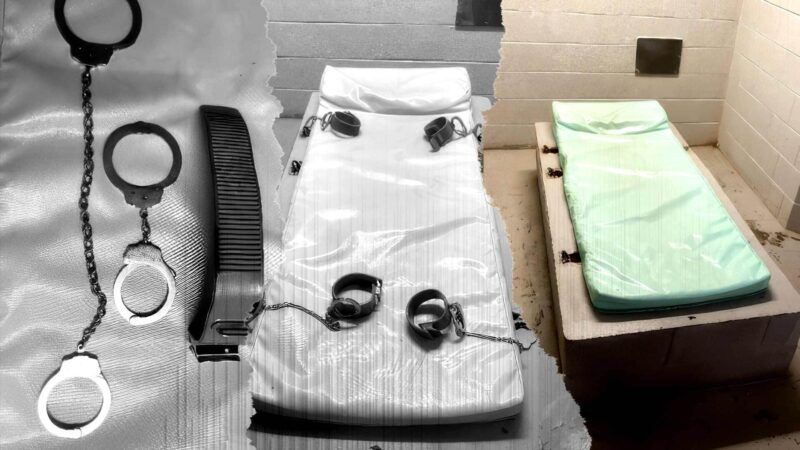A Federal Inmate Had a Limb Partially Amputated After Being Kept in Restraints for 2 Days
An inspector general report found there were no limits on how long federal inmates could be kept in restraint chairs or strapped to beds.

A federal inmate had to have one of his or her limbs partially amputated after being kept in restraints for two days. Another incarcerated person died after being pepper sprayed and left shackled in a restraint chair for five hours.
The Department of Justice Office of Inspector General (OIG), an independent watchdog agency, published those details in a memorandum released Monday that found inadequate policies and limited oversight of the use of physical restraints on inmates in the Bureau of Prisons (BOP).
The inspector general launched the investigation after receiving dozens of complaints a year from inmates alleging they were strapped to beds or chairs for long periods of time and assaulted or otherwise mistreated while restrained.
A 2022 investigation by The Marshall Project and NPR uncovered rampant abuse and deaths at U.S. Penitentiary Thomson, a federal prison in Illinois. "Specifically, many men reported being shackled in cuffs so tight they left scars, or being 'four-pointed' and chained by each limb to a bed for hours, far beyond what happens at other prisons and in violation of bureau policy and federal regulations," the report found. A follow-up investigation by the outlets published last December found dozens of similar allegations of prolonged shackling and abuse at another federal prison in Western Virginia.
BOP policy allows corrections staff to use restraints to gain control of disruptive inmates—ranging from ambulatory restraints that allow limited freedom of movement to four-point restraints and waist chains that render one immobile from the neck down. However, restraints are only supposed to be used as a last resort, and never as a method of punishment.
When the inspector general tried to investigate whether allegations of abuse were true, it was stymied by poor documentation and lack of video or audio evidence to verify whether staff were even performing required medical checks of inmates in restraints. Additionally, there were no limits on how long inmates could be kept in restraints and limited review of the use of restraints by regional headquarters.
"We found that shortcomings in BOP's policies and practices contributed to the concerns we identified and limited the availability of evidence that could either corroborate or refute inmates' accounts of what happened while they were in restraints, thereby impairing the OIG's ability to investigate allegations of misconduct by BOP employees," the memo says.
The danger of those shortcomings was underscored by one case uncovered by investigators, where an inmate was held in a combination of ambulatory restraints and a restraint chair for more than two days.
"The inmate's injury worsened to the point of needing hospitalization and amputation despite medical checks occurring at time intervals that complied with policy," the memo stated. "The medical checks were completed by different medical staff who did not discuss the progression of the inmate's injuries between shifts, and there were no photographs or video recordings to document that a medical check was actually performed and to show the progression of the inmate's injuries."
In another case, the inspector general found that an incarcerated person was "placed in a restraint chair with restraints on both wrists and both ankles for more than 2 days and then, less than 2 hours after being released from restraints, sprayed by BOP staff with Oleoresin Capsicum following an alleged altercation with a cellmate and placed back in the restraint chair for another approximately 5 hours until being discovered unresponsive."
The autopsy report listed the cause of death as "Vaso-Occlusive Crisis due to Sickle Cell Disease Complicating Oleoresin Capsicum Use and Prolonged Restraint Following Altercation."
The memo recommended improving guidelines and training for staff on when and how long inmates can be placed in restraints, strengthening the reporting requirements, and requiring audio and video recording of health checks of inmates in restraints.
The BOP concurred with all of the inspector general's recommendations and said in an official response letter that it is working to implement them.
"The BOP is committed to addressing these issues and implementing meaningful improvements and views OIG's recommendations as a crucial opportunity to enhance agency practices and ensure the humane treatment of all inmates," BOP Director William Marshall III wrote.


Show Comments (19)